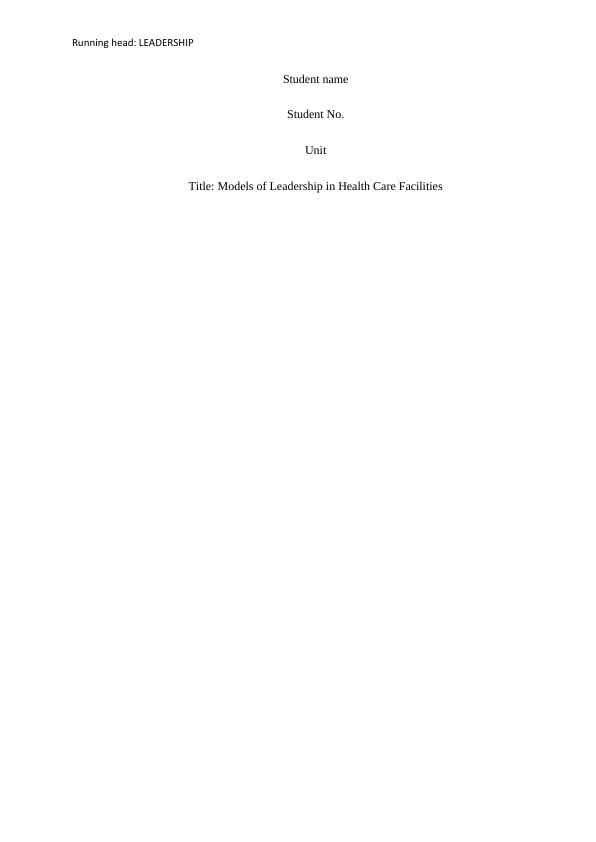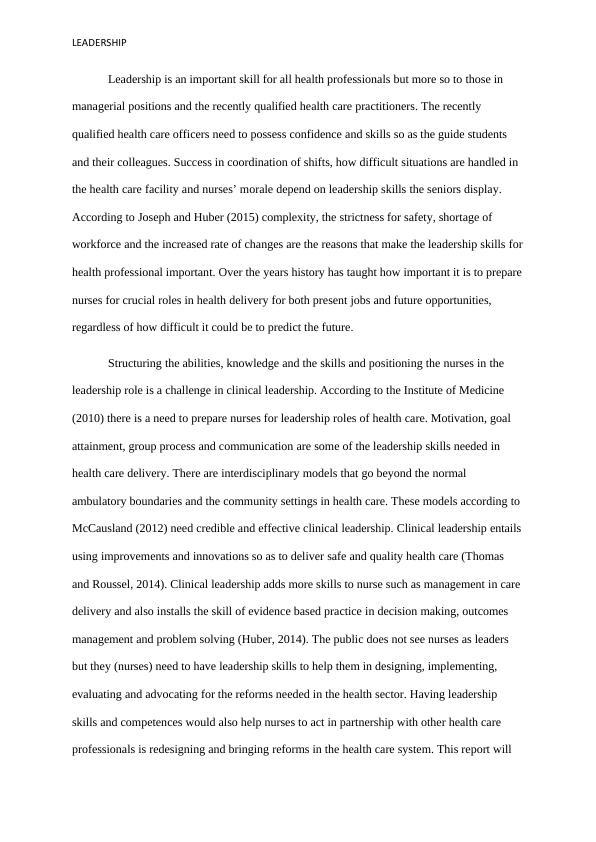Models of Leadership in Health Care Facilities
Added on 2023-01-19
9 Pages2527 Words89 Views
Running head: LEADERSHIP
Student name
Student No.
Unit
Title: Models of Leadership in Health Care Facilities
Student name
Student No.
Unit
Title: Models of Leadership in Health Care Facilities

LEADERSHIP
Leadership is an important skill for all health professionals but more so to those in
managerial positions and the recently qualified health care practitioners. The recently
qualified health care officers need to possess confidence and skills so as the guide students
and their colleagues. Success in coordination of shifts, how difficult situations are handled in
the health care facility and nurses’ morale depend on leadership skills the seniors display.
According to Joseph and Huber (2015) complexity, the strictness for safety, shortage of
workforce and the increased rate of changes are the reasons that make the leadership skills for
health professional important. Over the years history has taught how important it is to prepare
nurses for crucial roles in health delivery for both present jobs and future opportunities,
regardless of how difficult it could be to predict the future.
Structuring the abilities, knowledge and the skills and positioning the nurses in the
leadership role is a challenge in clinical leadership. According to the Institute of Medicine
(2010) there is a need to prepare nurses for leadership roles of health care. Motivation, goal
attainment, group process and communication are some of the leadership skills needed in
health care delivery. There are interdisciplinary models that go beyond the normal
ambulatory boundaries and the community settings in health care. These models according to
McCausland (2012) need credible and effective clinical leadership. Clinical leadership entails
using improvements and innovations so as to deliver safe and quality health care (Thomas
and Roussel, 2014). Clinical leadership adds more skills to nurse such as management in care
delivery and also installs the skill of evidence based practice in decision making, outcomes
management and problem solving (Huber, 2014). The public does not see nurses as leaders
but they (nurses) need to have leadership skills to help them in designing, implementing,
evaluating and advocating for the reforms needed in the health sector. Having leadership
skills and competences would also help nurses to act in partnership with other health care
professionals is redesigning and bringing reforms in the health care system. This report will
Leadership is an important skill for all health professionals but more so to those in
managerial positions and the recently qualified health care practitioners. The recently
qualified health care officers need to possess confidence and skills so as the guide students
and their colleagues. Success in coordination of shifts, how difficult situations are handled in
the health care facility and nurses’ morale depend on leadership skills the seniors display.
According to Joseph and Huber (2015) complexity, the strictness for safety, shortage of
workforce and the increased rate of changes are the reasons that make the leadership skills for
health professional important. Over the years history has taught how important it is to prepare
nurses for crucial roles in health delivery for both present jobs and future opportunities,
regardless of how difficult it could be to predict the future.
Structuring the abilities, knowledge and the skills and positioning the nurses in the
leadership role is a challenge in clinical leadership. According to the Institute of Medicine
(2010) there is a need to prepare nurses for leadership roles of health care. Motivation, goal
attainment, group process and communication are some of the leadership skills needed in
health care delivery. There are interdisciplinary models that go beyond the normal
ambulatory boundaries and the community settings in health care. These models according to
McCausland (2012) need credible and effective clinical leadership. Clinical leadership entails
using improvements and innovations so as to deliver safe and quality health care (Thomas
and Roussel, 2014). Clinical leadership adds more skills to nurse such as management in care
delivery and also installs the skill of evidence based practice in decision making, outcomes
management and problem solving (Huber, 2014). The public does not see nurses as leaders
but they (nurses) need to have leadership skills to help them in designing, implementing,
evaluating and advocating for the reforms needed in the health sector. Having leadership
skills and competences would also help nurses to act in partnership with other health care
professionals is redesigning and bringing reforms in the health care system. This report will

LEADERSHIP
focus majorly on the models of clinical leadership and their importance, strengths and
weaknesses as far as health care delivery is concerned.
Leadership according to Ceylan (2018) is a process whereby a person can influence
others (either an individual of a group) towards attaining a certain goal. The Institute of
Medicine (2011) a strong leadership is essential in realizing the dreams and visions in health
care system. Leaders must possess virtues such as honesty, inspiring, be reliable and
supportive, foreseeing and equalitarian, use their power appropriately, listen to others and
objectively evaluate them, be able to bring and support change, be aware of his power, clearly
express his opinions, should possess effective managerial and communication skills.
Leadership is a function of the quality of interaction between the leader and the subjects,
whereby a group of people is encouraged to voluntarily put more efforts in achieving a
common objective under some laid down conditions. Change leadership is the ability to
influence change in others and in an organization through vision and advocacy and access to
required resources and tools so as to come up with a rigid framework of change (Lapina,
2018). Change leadership entails powering up disruption that triggers and sustains change.
This disruption creates a platform for innovations and transformations (Brandham, 2017).
Change leadership has three main attributes according to Moslemi (2011). They are
communication, ownership and adaptability. For a person to show change leadership, they
must possess a variety of communication skills. A leader should display adaptability so that
the effectiveness of their leadership depends on situational characteristics and if the leader is
task oriented or relation oriented. Task oriented leaders have a directive leadership style,
making them effective in clarifying and defining responsibilities and making sure that their
employees understand their roles. Ownership is essential in change leadership. It helps a
leader evaluate success and failures in the firm, making the leader more proactive in
focus majorly on the models of clinical leadership and their importance, strengths and
weaknesses as far as health care delivery is concerned.
Leadership according to Ceylan (2018) is a process whereby a person can influence
others (either an individual of a group) towards attaining a certain goal. The Institute of
Medicine (2011) a strong leadership is essential in realizing the dreams and visions in health
care system. Leaders must possess virtues such as honesty, inspiring, be reliable and
supportive, foreseeing and equalitarian, use their power appropriately, listen to others and
objectively evaluate them, be able to bring and support change, be aware of his power, clearly
express his opinions, should possess effective managerial and communication skills.
Leadership is a function of the quality of interaction between the leader and the subjects,
whereby a group of people is encouraged to voluntarily put more efforts in achieving a
common objective under some laid down conditions. Change leadership is the ability to
influence change in others and in an organization through vision and advocacy and access to
required resources and tools so as to come up with a rigid framework of change (Lapina,
2018). Change leadership entails powering up disruption that triggers and sustains change.
This disruption creates a platform for innovations and transformations (Brandham, 2017).
Change leadership has three main attributes according to Moslemi (2011). They are
communication, ownership and adaptability. For a person to show change leadership, they
must possess a variety of communication skills. A leader should display adaptability so that
the effectiveness of their leadership depends on situational characteristics and if the leader is
task oriented or relation oriented. Task oriented leaders have a directive leadership style,
making them effective in clarifying and defining responsibilities and making sure that their
employees understand their roles. Ownership is essential in change leadership. It helps a
leader evaluate success and failures in the firm, making the leader more proactive in

End of preview
Want to access all the pages? Upload your documents or become a member.
Related Documents
Health Carelg...
|6
|825
|383
Leadership - Case Study Analysislg...
|11
|2925
|24
Clinical Leadershiplg...
|9
|2291
|277
Leadership and Professional Practicelg...
|8
|2757
|110
Leadership and Management in the Nursing Practice | Reportlg...
|15
|4753
|14
Nursing Leadership: Styles, Strategies, and Competencieslg...
|14
|3516
|107
